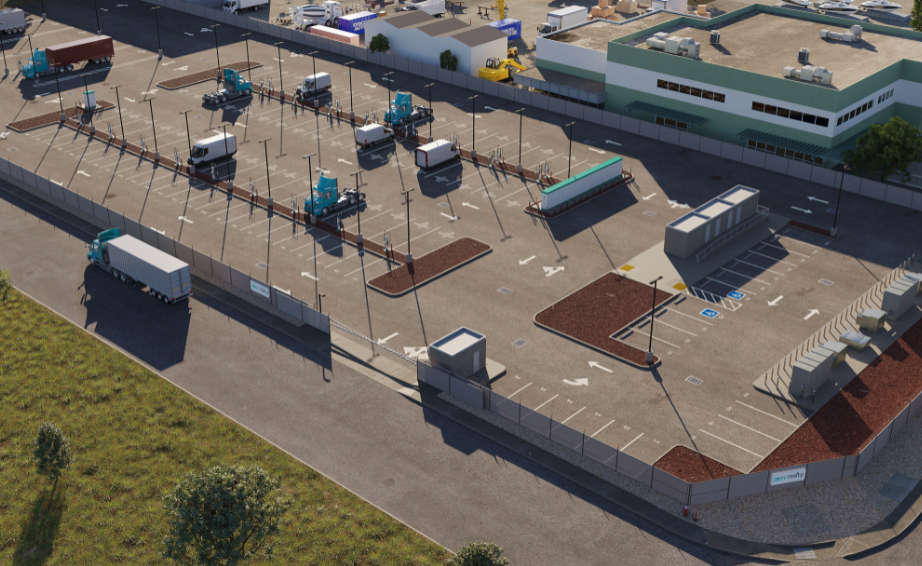Apr 18, 2024
Startups, real estate giants and others developing electric truck charging sites tend to pick locations before being certain they can get electricity in a timely fashion. Startup EV Realty prioritizes having the juice available when it buys a property.
‘Buying by the acre and monetizing by the megawatt’
Patrick Sullivan is like a lot of his peers developing electric infrastructure for fleet charging. He knows how the electric power business works, what it takes to develop and what can frustrate that work. His startup EV Realty begins with sites where electric power is already present.
It’s kind of like exploring for oil.
“The way we’re finding these sites with power is by analyzing down to each individual distribution circuit, to each individual property, [and then] tracking back to each individual substation where the system has latent capacity,” Sullivan told me. “Then we’re acquiring those properties.
“We are buying by the acre and monetizing by the megawatt. You could think of it as sitting on oil. Only we are not just sitting on it. We’re proactively going to build on it.”

The aptly named EV Realty isn’t concerned with immediately taking advantage of that power. It is a real estate developer first and an infrastructure builder second. Its name came from Digital Realty, a major developer of multiclient, power-hungry data centers.
“We are very much doing the same. We’re buying infill industrial property at a competitive price for somebody who might be looking at it for a warehouse or a truck terminal or a storage facility,” Sullivan said. “We’re breaking that cycle between what comes first: the truck or the charger.”
Even having the power available doesn’t make charging a turnkey operation.
“There’s a whole process that any developer needs to take to actually secure that power for themselves,” Sullivan said.
Financial backing and slow growth of electric fleets
There’s no rush to get charging sites for large fleets built because sizable fleets of medium- and heavy-duty electric trucks don’t yet exist.
“The reality is there’s 14,000 electric trucks on the road today in the entire United States,” Sullivan said. “There aren’t 200 trucks at a single location ready for a 10-year services contract.”
EV Realty expects to be ready when the fleets are. It has a joint venture with GreenPoint Partners that makes $200 million available in an equity line of credit for EV Realty to lease properties and develop and manage sites.
“We have the time to transition that real estate with our capital into these powered properties. But we don’t have to show up and say, ‘I’ve got Amazon with 200 trucks. Now, may I build this thing?’”
Starting in Northern California
Its first high-capacity site in Livermore, California — situated between the Port of Oakland and Port of Stockton adjacent to Interstate 580 — will be ready late this year or by early 2025.

(Artist rendering: EV Realty)
“We confirmed that there was a considerable amount of power there, in excess of 10 megawatts,” Sullivan said. “When we acquired the property, we took the proactive steps with the utility to reserve that load. So it is now no longer available on the system.”
Meeting power needs across electric truck classes
The Livermore site is being designed to handle charging needs for a variety of electric vehicles — from Amazon delivery vans to Class 8 battery-electric tractors. Charging rates vary from as little as 25 kilowatts to 600 kW, more than any Class 8 truck can presently handle, except for the Tesla Semi.
“For example, a fleet of 50 delivery vans that drive 75 miles on a single shift does not need to charge at 200 kW,” Sullivan said, explaining that overnight trickle charging at 25 kW would suffice. “During the day, that same stall could be used for a Class 8 tractor on a shift change that needs to go from 20% to 80% [state of charge] in the 40 minutes the driver is [on a break].”
EV Realty sees potential for 20 or more sites nationwide. For now, the focus is on California, where most electric trucks operate. The recently released National Zero Emission Freight Corridor Strategy that identifies charging hubs helps guide the joint venture’s efforts.
“These hubs are basically hundred-mile radiuses around a dozen ports in America,” Sullivan said. “That is exactly our strategy. And that makes sense, because the best Class 8 day cab today travels 238 miles on a charge.”

